by Jason Bodner
August 20, 2024
In May, a flight from London to Singapore was smooth until suddenly the plane underwent “un-commanded changes in altitude and airspeed,” according to the Transport Safety Investigation Bureau of Singapore. It dropped 40 feet per second (178 feet in 4.6 seconds), enough to cause half of the 229 passengers to need medical treatment. A fall like that can throw people (without seat belts attached) to the ceiling, only to have them crash down to their seats, or on top of other people – or whatever they hit.
I was once on such a flight, under dire conditions in a sudden drop, and the masks came down with a pop. We dropped quickly and then stabilized. We then saw a flight attendant dragging another unconscious flight attendant to a jump seat to be strapped into a seat belt. Thankfully, we were fine, but I experienced how things can change suddenly. I also realized that I don’t ever want to wear an oxygen mask again!
The moral of the story is: Wear your car or airline seat-belt all the time. You never know when you’ll hit an air pocket. Or maybe you do. When it comes to stocks, August and September are typically the bumpiest months of the year, followed by the smoothest – and best – three months of the year:
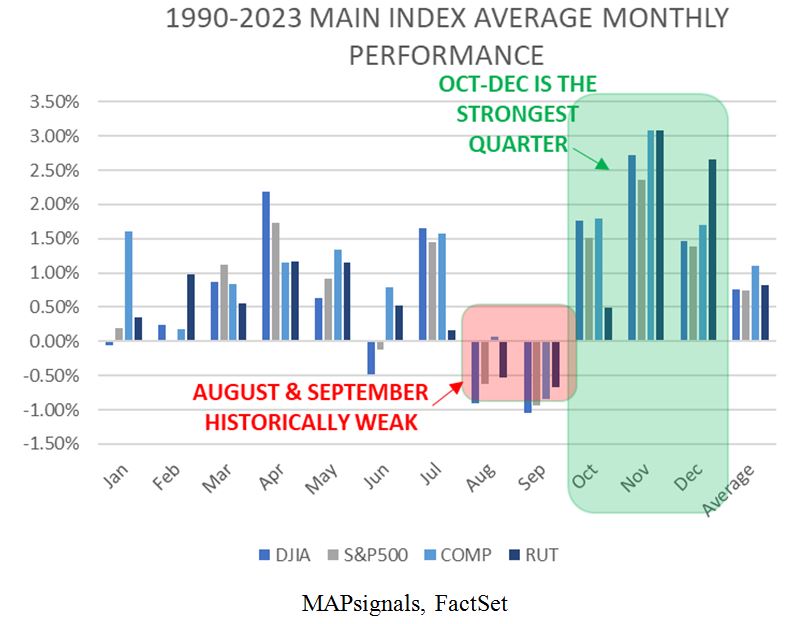
Graphs are for illustrative and discussion purposes only. Please read important disclosures at the end of this commentary.
This month certainly didn’t deviate from the norm… but if you woke up today after going to sleep on July 31st, you wouldn’t really think anything happened – the S&P 500 is up 0.58% in August through last Friday. Nvidia (NVDA))is up 6.5% in August and is back above $3 trillion in market cap and is trading just mildly off its all-time high made in June. It nearly eclipsed that high in mid-July only to plummet like that Singapore Airlines flight. It shed over $880 billion in market value in just about three weeks. To put that drop in perspective, there are only nine stocks that have a market value over the $880 billion in value drop from NVDA. In other words: 99.8% of the over 5,000 stocks I look at daily have values less than the value lost by NVDA in a few short weeks.
What I’m saying is that this August market air pocket, although predicted and volatile, caused a lot of rattled nerves, but it didn’t deliver a loss to most portfolios – at least for those who held on to their stocks.
The first thing we should notice is that this correction was rotational in nature. I’ll help you visualize that rotation in a moment, but this is a case of seeing “nothing out of the ordinary” when looking at the BMI.
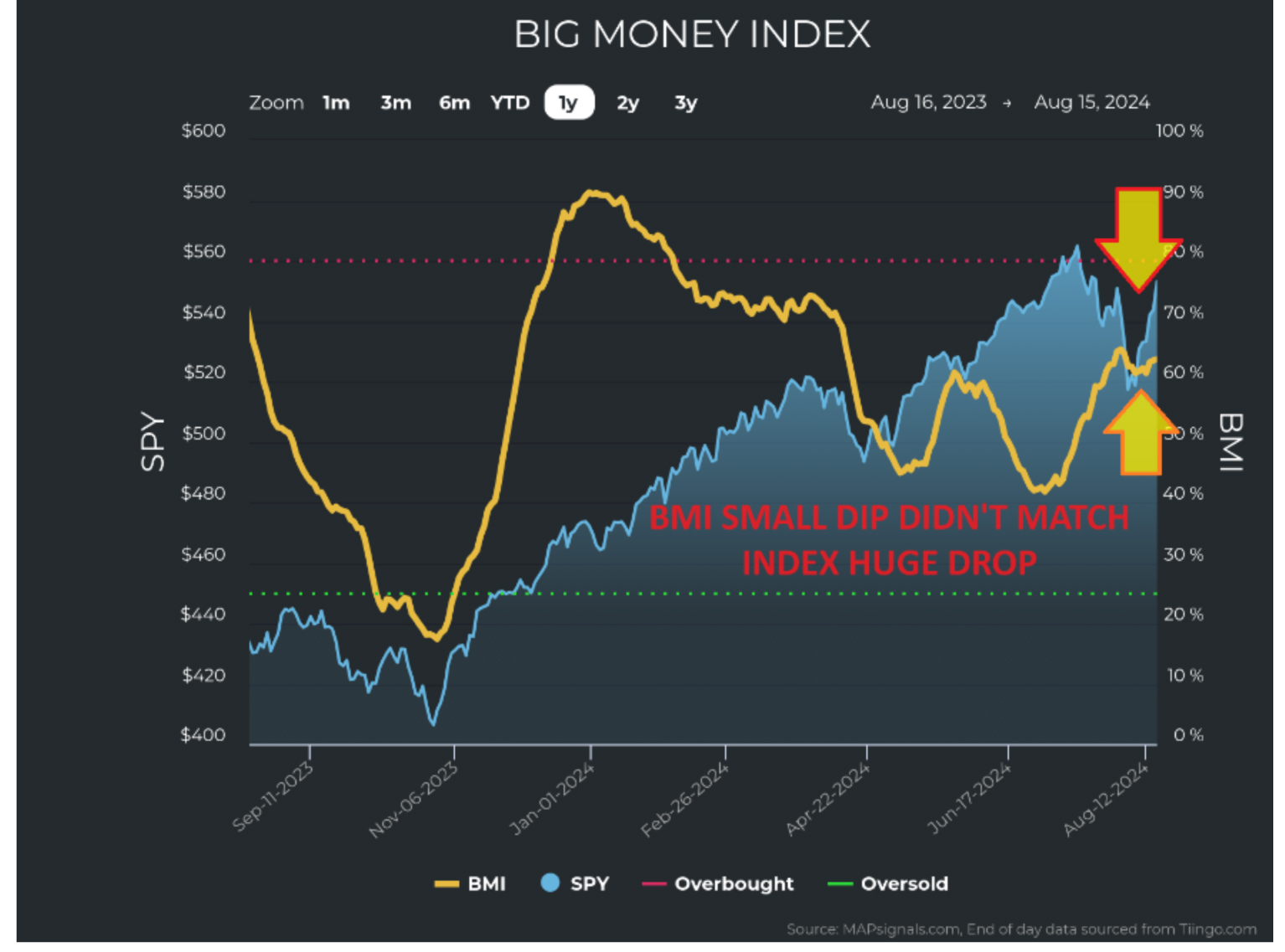
Graphs are for illustrative and discussion purposes only. Please read important disclosures at the end of this commentary.
This shows us an important distinction: The Big Money Index is an excellent indicator for trends of money flows, but it’s not great for alerting us about sudden air pockets. It tells us what the overall trend of unusual institutional money flows will mean for how a market trends over time. To anticipate air pockets, we need to evaluate unusual buying and selling day by day. For that, we turn to another type of chart:
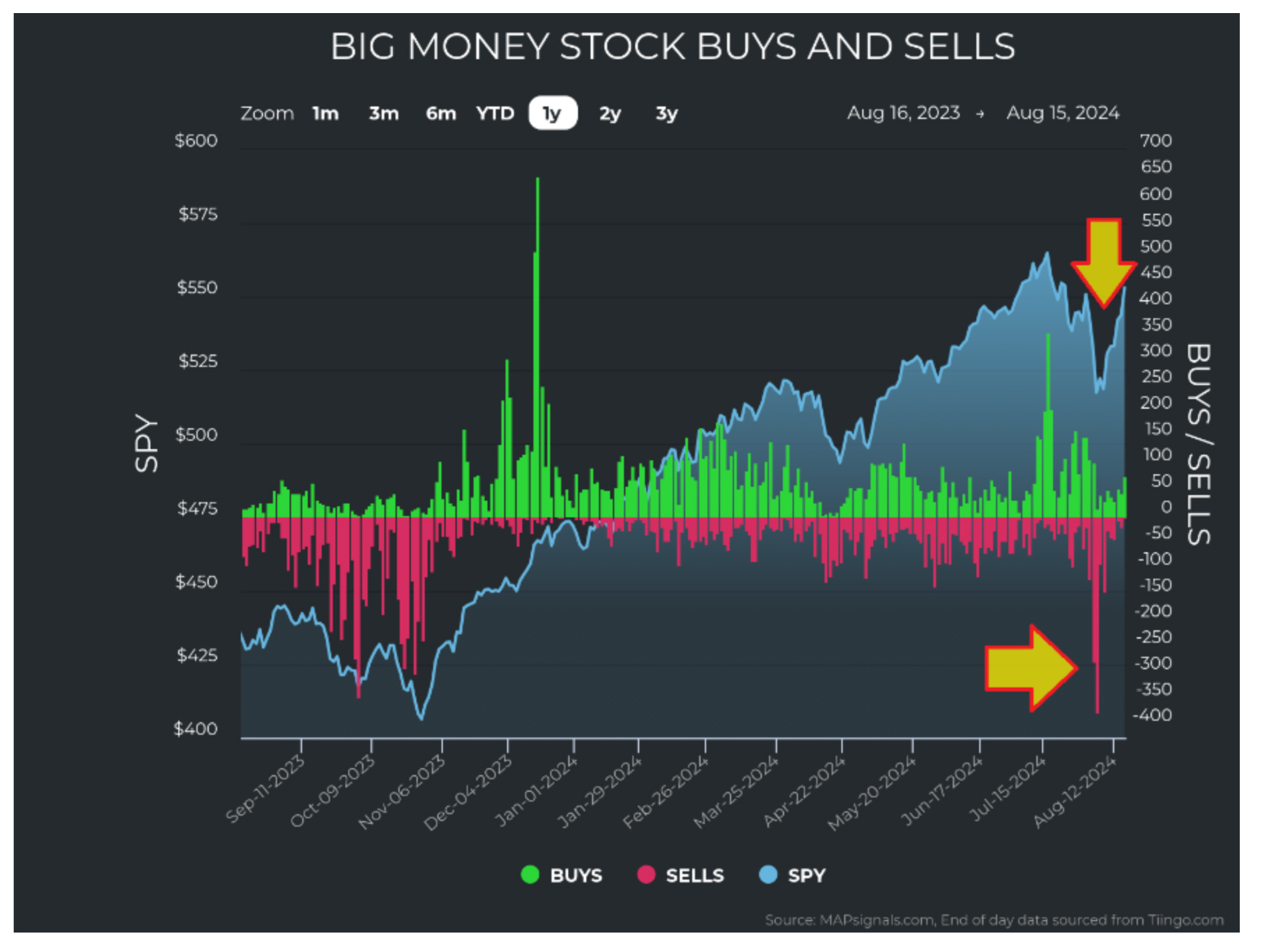
Graphs are for illustrative and discussion purposes only. Please read important disclosures at the end of this commentary.
The dramatic swing between buying and selling tells the story much better. Last week’s level of selling is the highest since September 23rd, 2022. The market however rallied more than 50% since then:
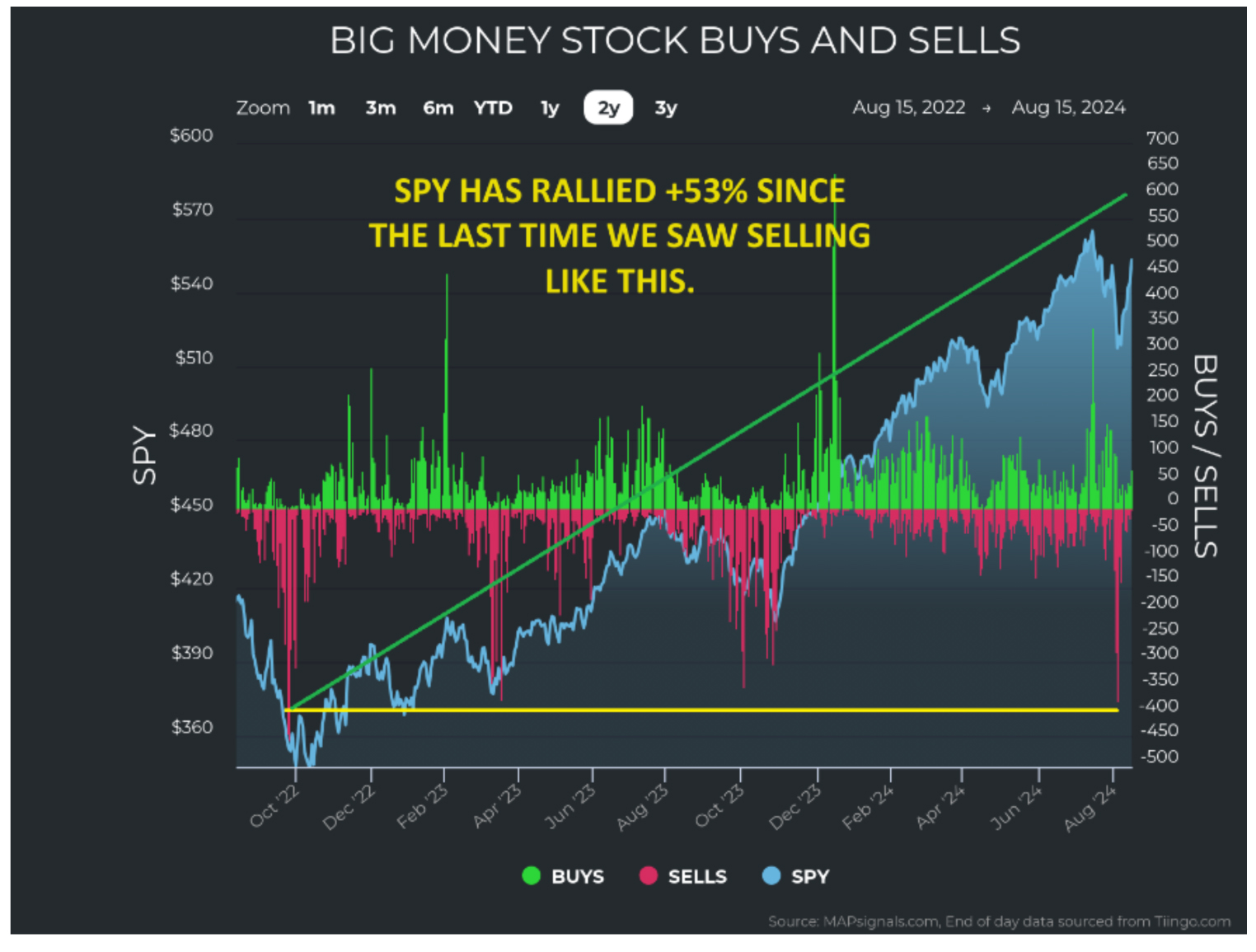
Graphs are for illustrative and discussion purposes only. Please read important disclosures at the end of this commentary.
Last week’s recovery was so swift – almost like early August never happened. We really see it when we map buys and sells vs. the indexes. On the left you will see how steep the fall was for NASDAQ stocks (QQQ), while on the right you see the manic-depressive action of the Russell 2000 (IWM):
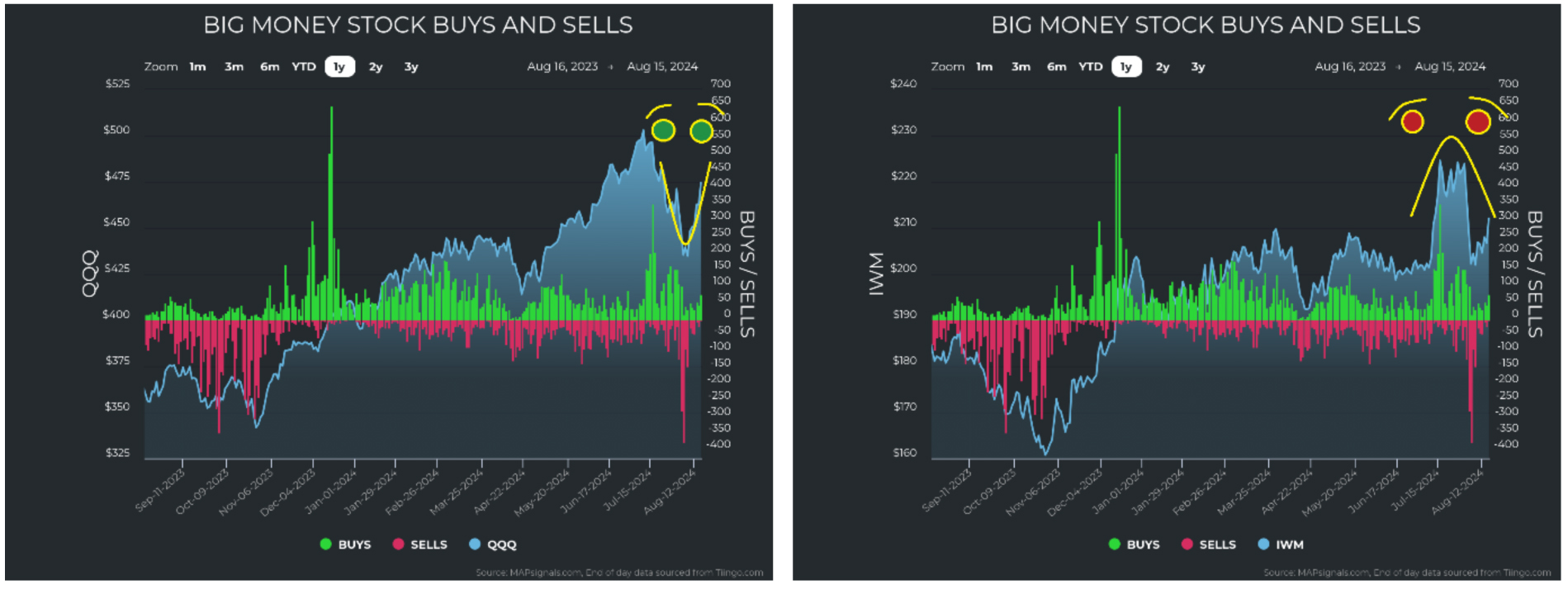
Graphs are for illustrative and discussion purposes only. Please read important disclosures at the end of this commentary.
First, we see the SPY recovery is better on an absolute basis. QQQ’s fall was steeper, and the bounce was steeper. IWM may look schizophrenic, but it underpins the conflicting opinions about the near future.
As the election polls between Trump and Harris narrow, large cap tech is poised to continue to benefit under a Harris (extension of Biden) administration, which historically favored mega-cap technology over small-caps. But the sharp bounce for IWM shows how small caps will benefit regardless of who wins… because when rates fall, which they surely will, we all win.
In another view, look at the distribution of unusual buying and selling separated by one week:
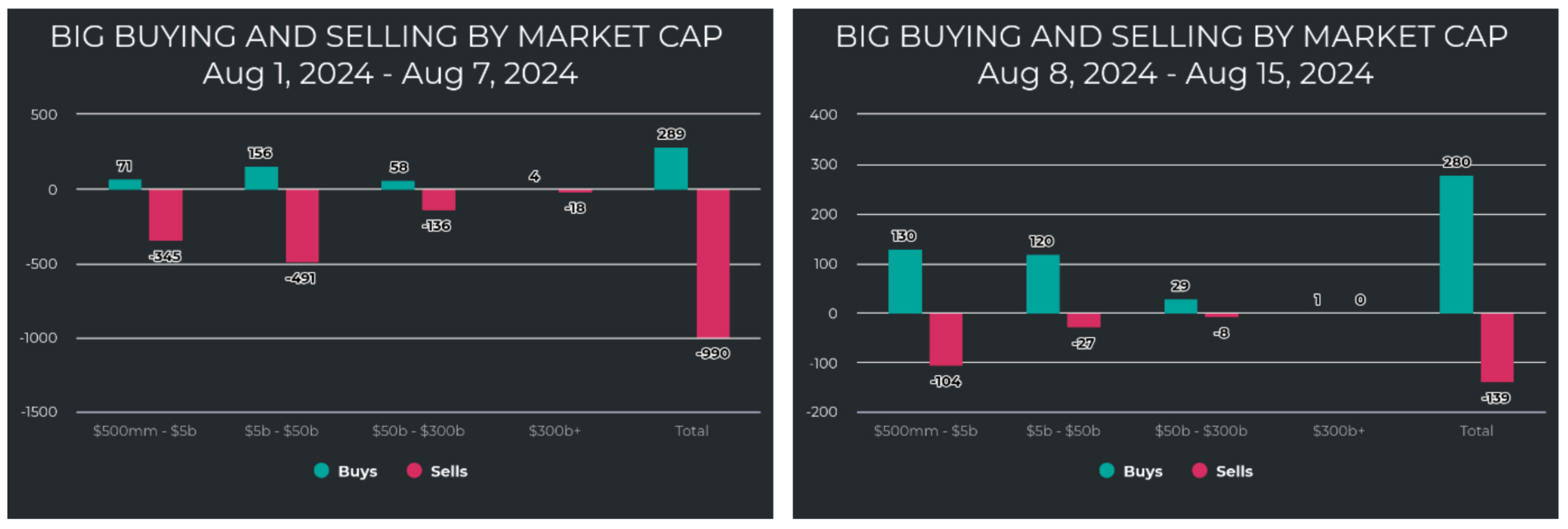
Graphs are for illustrative and discussion purposes only. Please read important disclosures at the end of this commentary.
Immense selling took place in small-cap and mid-cap stocks, only to be scooped up a week later. This tells us that the selling was a classic head-fake. Low-liquidity August provided perfect conditions for algorithm-traders to push stocks down unbelievably, only to buy them back and book enough profits for new yachts.
In yet another view of why this capitulation selling is constructive, long-term, look at the explosive ETF selling. We haven’t seen ETF selling like this since October of 2023. Looking back over the last three years, you can see how massive ETF selling tends to highlight troughs:
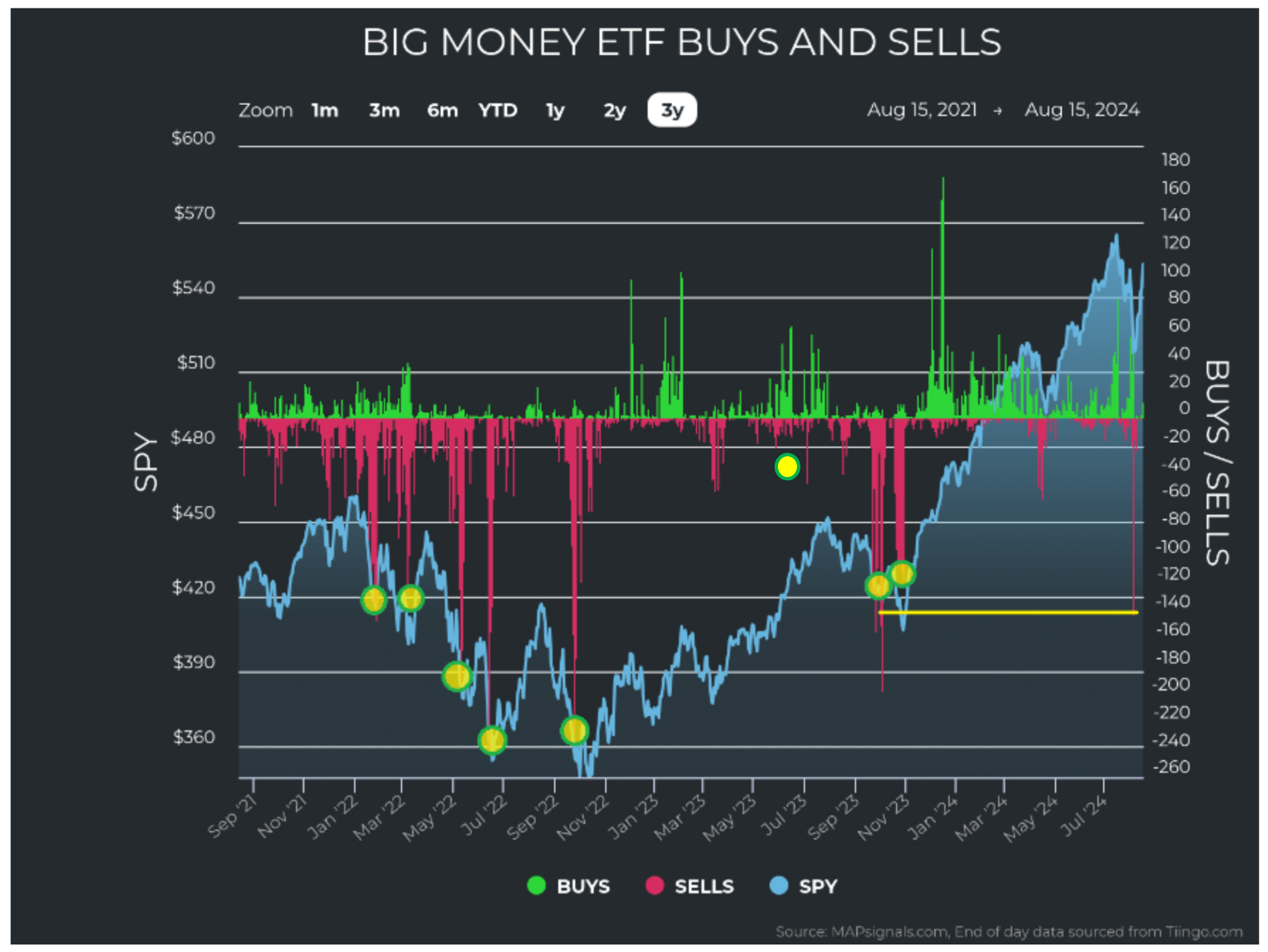
Graphs are for illustrative and discussion purposes only. Please read important disclosures at the end of this commentary.
Extending this analysis, we looked back at similar days of ETF selling in history. August 5th saw 142 ETFs sold heavily. There were 21 prior times when selling reached that level.
Here are the forward returns of the S&P 500:
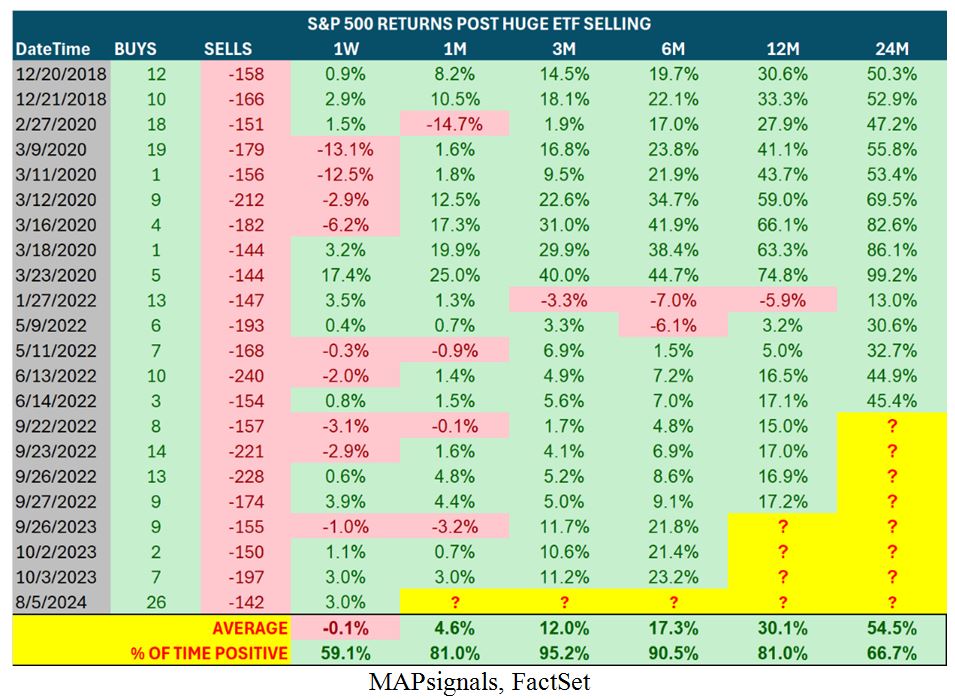
Graphs are for illustrative and discussion purposes only. Please read important disclosures at the end of this commentary.
All of this volatility is on the surface. Looking beneath, we see heavy rotation. The Sector Strength and Weakness charts (below) show the violent moves within the sectors. The left-most chart is July 1st, the middle is August 7th, and the right is August 15th. Technology and Energy fell from #1 and #2 in July to #6 and #7 on August 7th. Then Technology bounced back to #3 while Energy kept falling. Meanwhile Real Estate and Utilities rose from #8 and #9 to #1 and #3 on August 7th. Then Real Estate fell.
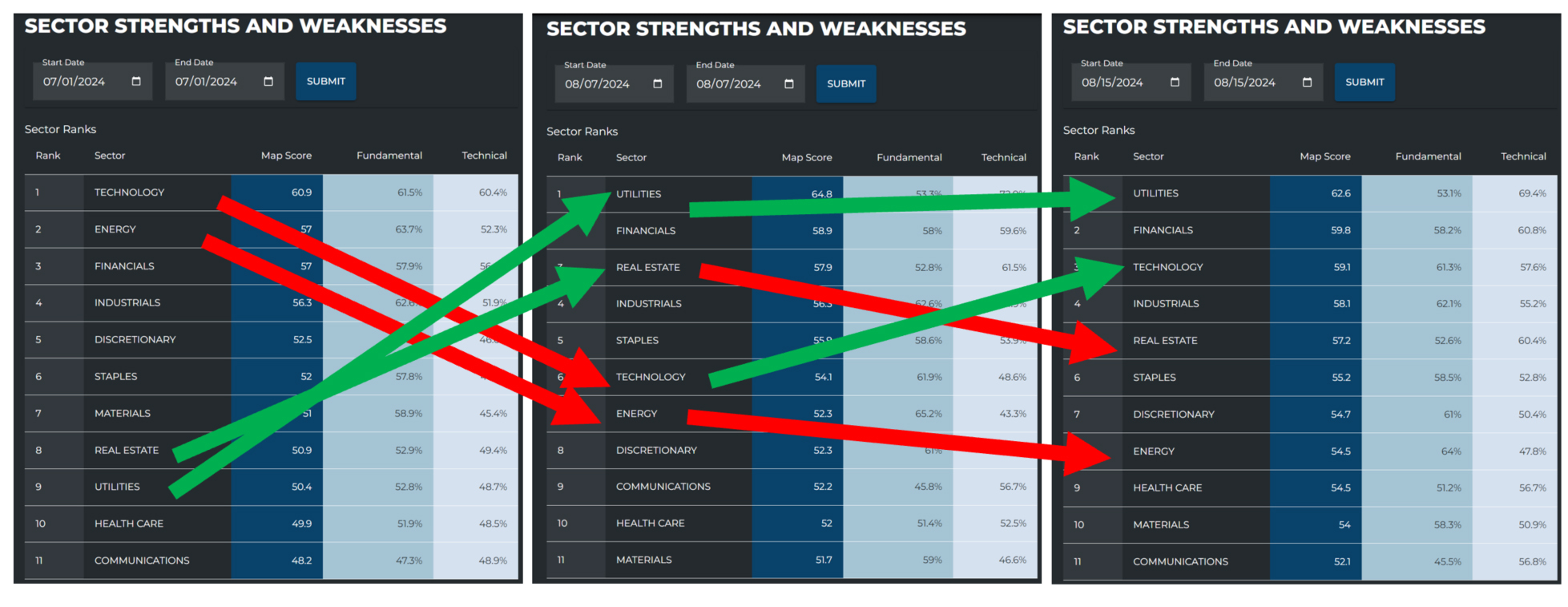
Graphs are for illustrative and discussion purposes only. Please read important disclosures at the end of this commentary.
This is what a major head-fake looks like. The big picture is that rates are falling, which will stimulate the economy, and stocks will benefit from that. I am looking forward to a bull run from the election onward. barring any unexpected geopolitical eruptions. So, let’s focus on owning fundamentally superior, institutionally supported stocks. Then sit back and enjoy the ride… but remember, wear your seat-belt!
Remember what Ben Franklin said: “An ounce of prevention is worth a pound of cure.”
Navellier & Associates owns Nvidia Corp (NVDA), in managed accounts. Jason Bodner owns Nvidia Corp (NVDA), via a managed account, and in a personal account.
All content above represents the opinion of Jason Bodner of Navellier & Associates, Inc.
Also In This Issue
A Look Ahead by Louis Navellier
Central Banks Could Announce a “Round of Cuts” This Week in Wyoming
Income Mail by Bryan Perry
A Goldilocks Economy Begets Rising Gold Prices – What Gives?
Growth Mail by Gary Alexander
Zombie Price Controls Revived (by Economic Dummkopfs)
Global Mail by Ivan Martchev
This Latest Feels Like an Upside Overshoot
Sector Spotlight by Jason Bodner
To Prepare for “Air Pockets” – Always Wear Your Seat Belt
View Full Archive
Read Past Issues Here

Jason Bodner
MARKETMAIL EDITOR FOR SECTOR SPOTLIGHT
Jason Bodner writes Sector Spotlight in the weekly Marketmail publication and has authored several white papers for the company. He is also Co-Founder of Macro Analytics for Professionals which produces proprietary equity accumulation and distribution research for its clients. Previously, Mr. Bodner served as Director of European Equity Derivatives for Cantor Fitzgerald Europe in London, then moved to the role of Head of Equity Derivatives North America for the same company in New York. He also served as S.V.P. Equity Derivatives for Jefferies, LLC. He received a B.S. in business administration in 1996, with honors, from Skidmore College as a member of the Periclean Honors Society. All content of “Sector Spotlight” represents the opinion of Jason Bodner
Important Disclosures:
Jason Bodner is a co-founder and co-owner of Mapsignals. Mr. Bodner is an independent contractor who is occasionally hired by Navellier & Associates to write an article and or provide opinions for possible use in articles that appear in Navellier & Associates weekly Market Mail. Mr. Bodner is not employed or affiliated with Louis Navellier, Navellier & Associates, Inc., or any other Navellier owned entity. The opinions and statements made here are those of Mr. Bodner and not necessarily those of any other persons or entities. This is not an endorsement, or solicitation or testimonial or investment advice regarding the BMI Index or any statements or recommendations or analysis in the article or the BMI Index or Mapsignals or its products or strategies.
Although information in these reports has been obtained from and is based upon sources that Navellier believes to be reliable, Navellier does not guarantee its accuracy and it may be incomplete or condensed. All opinions and estimates constitute Navellier’s judgment as of the date the report was created and are subject to change without notice. These reports are for informational purposes only and are not a solicitation for the purchase or sale of a security. Any decision to purchase securities mentioned in these reports must take into account existing public information on such securities or any registered prospectus.To the extent permitted by law, neither Navellier & Associates, Inc., nor any of its affiliates, agents, or service providers assumes any liability or responsibility nor owes any duty of care for any consequences of any person acting or refraining to act in reliance on the information contained in this communication or for any decision based on it.
Past performance is no indication of future results. Investment in securities involves significant risk and has the potential for partial or complete loss of funds invested. It should not be assumed that any securities recommendations made by Navellier. in the future will be profitable or equal the performance of securities made in this report. Dividend payments are not guaranteed. The amount of a dividend payment, if any, can vary over time and issuers may reduce dividends paid on securities in the event of a recession or adverse event affecting a specific industry or issuer.
None of the stock information, data, and company information presented herein constitutes a recommendation by Navellier or a solicitation to buy or sell any securities. Any specific securities identified and described do not represent all of the securities purchased, sold, or recommended for advisory clients. The holdings identified do not represent all of the securities purchased, sold, or recommended for advisory clients and the reader should not assume that investments in the securities identified and discussed were or will be profitable.
Information presented is general information that does not take into account your individual circumstances, financial situation, or needs, nor does it present a personalized recommendation to you. Individual stocks presented may not be suitable for every investor. Investment in securities involves significant risk and has the potential for partial or complete loss of funds invested. Investment in fixed income securities has the potential for the investment return and principal value of an investment to fluctuate so that an investor’s holdings, when redeemed, may be worth less than their original cost.
One cannot invest directly in an index. Index is unmanaged and index performance does not reflect deduction of fees, expenses, or taxes. Presentation of Index data does not reflect a belief by Navellier that any stock index constitutes an investment alternative to any Navellier equity strategy or is necessarily comparable to such strategies. Among the most important differences between the Indices and Navellier strategies are that the Navellier equity strategies may (1) incur material management fees, (2) concentrate its investments in relatively few stocks, industries, or sectors, (3) have significantly greater trading activity and related costs, and (4) be significantly more or less volatile than the Indices.
ETF Risk: We may invest in exchange traded funds (“ETFs”) and some of our investment strategies are generally fully invested in ETFs. Like traditional mutual funds, ETFs charge asset-based fees, but they generally do not charge initial sales charges or redemption fees and investors typically pay only customary brokerage fees to buy and sell ETF shares. The fees and costs charged by ETFs held in client accounts will not be deducted from the compensation the client pays Navellier. ETF prices can fluctuate up or down, and a client account could lose money investing in an ETF if the prices of the securities owned by the ETF go down. ETFs are subject to additional risks:
- ETF shares may trade above or below their net asset value;
- An active trading market for an ETF’s shares may not develop or be maintained;
- The value of an ETF may be more volatile than the underlying portfolio of securities the ETF is designed to track;
- The cost of owning shares of the ETF may exceed those a client would incur by directly investing in the underlying securities and;
- Trading of an ETF’s shares may be halted if the listing exchange’s officials deem it appropriate, the shares are delisted from the exchange, or the activation of market-wide “circuit breakers” (which are tied to large decreases in stock prices) halts stock trading generally.
Grader Disclosures: Investment in equity strategies involves substantial risk and has the potential for partial or complete loss of funds invested. The sample portfolio and any accompanying charts are for informational purposes only and are not to be construed as a solicitation to buy or sell any financial instrument and should not be relied upon as the sole factor in an investment making decision. As a matter of normal and important disclosures to you, as a potential investor, please consider the following: The performance presented is not based on any actual securities trading, portfolio, or accounts, and the reported performance of the A, B, C, D, and F portfolios (collectively the “model portfolios”) should be considered mere “paper” or pro forma performance results based on Navellier’s research.
Investors evaluating any of Navellier & Associates, Inc.’s, (or its affiliates’) Investment Products must not use any information presented here, including the performance figures of the model portfolios, in their evaluation of any Navellier Investment Products. Navellier Investment Products include the firm’s mutual funds and managed accounts. The model portfolios, charts, and other information presented do not represent actual funded trades and are not actual funded portfolios. There are material differences between Navellier Investment Products’ portfolios and the model portfolios, research, and performance figures presented here. The model portfolios and the research results (1) may contain stocks or ETFs that are illiquid and difficult to trade; (2) may contain stock or ETF holdings materially different from actual funded Navellier Investment Product portfolios; (3) include the reinvestment of all dividends and other earnings, estimated trading costs, commissions, or management fees; and, (4) may not reflect prices obtained in an actual funded Navellier Investment Product portfolio. For these and other reasons, the reported performances of model portfolios do not reflect the performance results of Navellier’s actually funded and traded Investment Products. In most cases, Navellier’s Investment Products have materially lower performance results than the performances of the model portfolios presented.
This report contains statements that are, or may be considered to be, forward-looking statements. All statements that are not historical facts, including statements about our beliefs or expectations, are “forward-looking statements” within the meaning of The U.S. Private Securities Litigation Reform Act of 1995. These statements may be identified by such forward-looking terminology as “expect,” “estimate,” “plan,” “intend,” “believe,” “anticipate,” “may,” “will,” “should,” “could,” “continue,” “project,” or similar statements or variations of such terms. Our forward-looking statements are based on a series of expectations, assumptions, and projections, are not guarantees of future results or performance, and involve substantial risks and uncertainty as described in Form ADV Part 2A of our filing with the Securities and Exchange Commission (SEC), which is available at www.adviserinfo.sec.gov or by requesting a copy by emailing info@navellier.com. All of our forward-looking statements are as of the date of this report only. We can give no assurance that such expectations or forward-looking statements will prove to be correct. Actual results may differ materially. You are urged to carefully consider all such factors.
FEDERAL TAX ADVICE DISCLAIMER: As required by U.S. Treasury Regulations, you are informed that, to the extent this presentation includes any federal tax advice, the presentation is not written by Navellier to be used, and cannot be used, for the purpose of avoiding federal tax penalties. Navellier does not advise on any income tax requirements or issues. Use of any information presented by Navellier is for general information only and does not represent tax advice either express or implied. You are encouraged to seek professional tax advice for income tax questions and assistance.
IMPORTANT NEWSLETTER DISCLOSURE:The hypothetical performance results for investment newsletters that are authored or edited by Louis Navellier, including Louis Navellier’s Growth Investor, Louis Navellier’s Breakthrough Stocks, Louis Navellier’s Accelerated Profits, and Louis Navellier’s Platinum Club, are not based on any actual securities trading, portfolio, or accounts, and the newsletters’ reported hypothetical performances should be considered mere “paper” or proforma hypothetical performance results and are not actual performance of real world trades. Navellier & Associates, Inc. does not have any relation to or affiliation with the owner of these newsletters. There are material differences between Navellier Investment Products’ portfolios and the InvestorPlace Media, LLC newsletter portfolios authored by Louis Navellier. The InvestorPlace Media, LLC newsletters contain hypothetical performance that do not include transaction costs, advisory fees, or other fees a client might incur if actual investments and trades were being made by an investor. As a result, newsletter performance should not be used to evaluate Navellier Investment services which are separate and different from the newsletters. The owner of the newsletters is InvestorPlace Media, LLC and any questions concerning the newsletters, including any newsletter advertising or hypothetical Newsletter performance claims, (which are calculated solely by Investor Place Media and not Navellier) should be referred to InvestorPlace Media, LLC at (800) 718-8289.
Please note that Navellier & Associates and the Navellier Private Client Group are managed completely independent of the newsletters owned and published by InvestorPlace Media, LLC and written and edited by Louis Navellier, and investment performance of the newsletters should in no way be considered indicative of potential future investment performance for any Navellier & Associates separately managed account portfolio. Potential investors should consult with their financial advisor before investing in any Navellier Investment Product.
Navellier claims compliance with Global Investment Performance Standards (GIPS). To receive a complete list and descriptions of Navellier’s composites and/or a presentation that adheres to the GIPS standards, please contact Navellier or click here. It should not be assumed that any securities recommendations made by Navellier & Associates, Inc. in the future will be profitable or equal the performance of securities made in this report.
FactSet Disclosure: Navellier does not independently calculate the statistical information included in the attached report. The calculation and the information are provided by FactSet, a company not related to Navellier. Although information contained in the report has been obtained from FactSet and is based on sources Navellier believes to be reliable, Navellier does not guarantee its accuracy, and it may be incomplete or condensed. The report and the related FactSet sourced information are provided on an “as is” basis. The user assumes the entire risk of any use made of this information. Investors should consider the report as only a single factor in making their investment decision. The report is for informational purposes only and is not intended as an offer or solicitation for the purchase or sale of a security. FactSet sourced information is the exclusive property of FactSet. Without prior written permission of FactSet, this information may not be reproduced, disseminated or used to create any financial products. All indices are unmanaged and performance of the indices include reinvestment of dividends and interest income, unless otherwise noted, are not illustrative of any particular investment and an investment cannot be made in any index. Past performance is no guarantee of future results.
